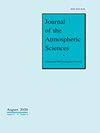Generation of Multiple Gravity Wave Couplets from Convection
IF 2.8
3区 地球科学
Q2 METEOROLOGY & ATMOSPHERIC SCIENCES
引用次数: 0
Abstract
The generation of multiple wave couplets with deep tropospheric downdrafts/updrafts by convection is explored through idealized 2D moist numerical simulations as well as dry experiments with prescribed artificial latent heating. These wave couplets are capable of horizontally propagating over a long distance at a fast speed with vertical motions spanning the entire troposphere. The timing of wave generation is determined by the variation in the local heating rate, which arose from the imbalances among latent heating, nonlinear advection and adiabatic heating/cooling. The amplitudes of wave couplets also correspond well with the strength of the local heating rate. The heat budget analysis highlights the crucial roles of both latent heating and nonlinear advection in the generation of the tropospheric wave couplets. Strong latent heating induces the thermodynamic imbalance and thus triggers waves. Meanwhile, latent heating also increases vertical motion in the source region and thus enhances nonlinear advection through transferring heat upward. Nonlinear advection, which has a comparable magnitude to latent heating in the upper troposphere, partially offsets the balancing effect of adiabatic heating/cooling, and results in a more persistent imbalance at high levels, allowing for the emission of consecutive waves even when latent heating becomes weak. In the simulation with weak nonlinear advection, fewer wave couplets are found, as the effect of latent heating is more easily offset by adiabatic cooling before it weakens.对流产生多重重力波偶
通过理想化的二维潮湿数值模拟以及规定的人工潜热的干燥实验,探索了对流产生的具有深对流层下气流/上气流的多波偶。这些波偶能够以快速的速度在长距离水平传播,垂直运动覆盖整个对流层。波浪产生的时间由局部加热速率的变化决定,局部加热速率是由潜热、非线性平流和绝热加热/冷却之间的不平衡引起的。波偶的振幅也与局部加热速率的强度很好地对应。热量预算分析强调了潜热和非线性平流在对流层波偶产生中的关键作用。强烈的潜热会导致热力学失衡,从而引发波浪。同时,潜热也增加了源区的垂直运动,从而通过向上传递热量来增强非线性平流。非线性平流的大小与对流层上部的潜热相当,部分抵消了绝热加热/冷却的平衡效应,并在高层造成更持久的不平衡,即使潜热变弱,也可以发射连续波。在弱非线性平流的模拟中,由于潜热的影响在减弱之前更容易被绝热冷却抵消,因此发现的波偶较少。
本文章由计算机程序翻译,如有差异,请以英文原文为准。
求助全文
约1分钟内获得全文
求助全文
来源期刊

Journal of the Atmospheric Sciences
地学-气象与大气科学
CiteScore
0.20
自引率
22.60%
发文量
196
审稿时长
3-6 weeks
期刊介绍:
The Journal of the Atmospheric Sciences (JAS) publishes basic research related to the physics, dynamics, and chemistry of the atmosphere of Earth and other planets, with emphasis on the quantitative and deductive aspects of the subject.
The links provide detailed information for readers, authors, reviewers, and those who wish to submit a manuscript for consideration.
 求助内容:
求助内容: 应助结果提醒方式:
应助结果提醒方式:


